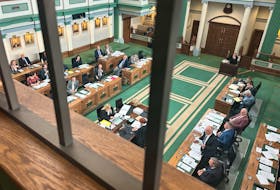
The impending half-decade of deficits is in addition to the $916-million shortfall forecast for this year.
A cabinet order from late January authorizes Wiseman to go to the bond market and raise up to $1 billion.
Wiseman said not all of that is new borrowing — some of it is rolling over federal debt related to equalization, and some of it is related to the pension deal struck last year.
All the same, the debt is going to start increasing.
“We’re only going to be borrowing about $700 million between now any the end of the year,” Wiseman said.
That’s just the appetizer, though. The main course will come a few months from now when Wiseman delivers his 2015 budget and revises the long-term forecast.
Last spring, the government was forecasting a surplus for 2015 and another one for 2016. Then the price of oil collapsed — from above $100 per barrel down to below $50 last month — and the deficit ballooned.
Now, instead of returning to surplus in 2015, Wiseman is talking about a five-year plan and a lot of red ink during that time.
“We won’t be able to return to a surplus budget over the next five years,” he said.
The big shift for Wiseman, though, isn’t primarily about oil; it’s about infrastructure.
He said the government has been spending a lot of oil money over the past decade as prices went up, and that can’t continue.
“We need to now realign our annual expenditure on infrastructure, because we’ve been spending somewhere in the range of $600-700 million in infrastructure. That’s not sustainable in the long term,” he said. “Now that we’ve dealt with a lot of the more critical infrastructure deficits that we’ve had, we’re able to ratchet that back.”
The news of further deficits over the next few years is welcome news to NDP Leader Lorraine Michael, who has recently been worried about the government slashing and burning to maintain a balanced budget.
Michael’s biggest concern was that she wanted more details.
“Running deficits is not a problem, but it’s really a problem if government is going to have deficits for five years, that we know very, very specifically what that means,” she said. “How much, per year, are we talking about? And I guess we’re not going to find that out until we get back into the House of Assembly.”
Liberal finance critic Cathy Bennett said the new borrowing and increased debt is a very big deal, though.
She said that right now, the province can keep borrowing, but at some point, lenders will stop providing money and the government will need to make a sharp course correction.
“When you have to make radical changes and fast cuts, then you typically will do it in a way that isn’t in the best interests of service delivery,” she said.
Bennett said she can’t specify what the Liberals would do differently.
“I need to see the books. I don’t have the same information the finance minister has, because we’re in opposition,” she said. “Until we see the books and get a real deep understanding, I can’t tell you what we’d do.”
By the numbers:
Current deficit forecast: $916 million (due to lower oil prices, the deficit will almost certainly be bigger than that);
Net debt as of March 2014: $9.1 billion (it was $8.3 billion in 2013, and the government is getting ready to borrow $700 million more);
Price of oil: $61 per barrel (it dropped below $50 last month, and has rebounded a bit, but it’s still a long way from the $105 per barrel of last spring);
Years until return to surplus: Five (according to Finance Minister Ross Wiseman).
Twitter: TelegramJames








